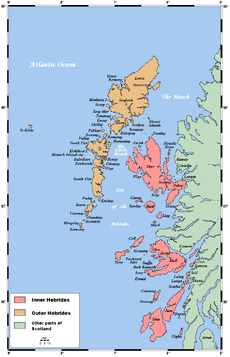Skye




Skye is the largest and most northerly island in the Inner Hebrides of Scotland.[1] More than 9000 people live there, and half of the people speak Gaelic. The main settlement is Portree, known for its picturesque harbour.
The island has been occupied since the mesolithic period and has a colourful history. It was rule by the Norse for 400 years, then dominated by Clan MacLeod and Clan Donald. The Highland Clearances of the 19th century caused a decline in the population from over 20,000 to around 9,200 in the early 21st century. The population has risen 4% from the census of 1991.[2] The main industries are tourism, agriculture, fishing and whisky-distilling.
Skye is part of the Highland Council local government area and is now linked to the mainland by a road bridge.[3] The island is renowned for its spectacular scenery, vibrant culture and heritage, and its abundant wildlife, including the Golden Eagle, Red Deer and Atlantic Salmon.
The Clans[change | change source]
Skye has a rich heritage of ancient monuments from the clans, especially castles. Dunvegan Castle has been the seat of Clan MacLeod since the 13th century. It may have been inhabited by a single family for longer than any other house in Scotland.[4]
The 18th century Armadale Castle, once home of Clan Donald was abandoned as a residence in 1925 but now hosts the Clan Donald Centre.[5] Nearby are the ruins of two more MacDonald strongholds, Knock Castle, and Dunscaith Castle, the legendary home of Queen Scáthach.[6][7]
Geography[change | change source]
At 1,656 square kilometres (639 sq mi), Skye is the second-largest island in Scotland after Lewis and Harris.
The Black Cuilin[change | change source]


The Black Cuillin, low mountains mainly composed of basalt and gabbro, include 12 peaks the Scots call 'Munros'. This is some of the most dramatic and challenging mountain terrain in Scotland. The ascent of Sgùrr a' Ghreadaidh is one of the longest rock climbs in Britain and the Inaccessible Pinnacle is the only peak in Scotland that requires technical climbing skills to reach the summit.[6][8] A full crossing of the Cuillin ridge may take 15–20 hours to complete.[9]
References[change | change source]
- ↑ Scottish Gaelic: An t-Eilean Sgitheanach or Eilean a' Cheò
- ↑ "Scotland's Island Populations". The Scottish Islands Federation. Archived from the original on 29 September 2018. Retrieved 29 September 2007.
- ↑ Last ferry to Skye - Christopher J. Uncles ISBN 978-1-84033-425-8
- ↑ "Dunvegan Castle" Archived 2013-08-02 at the Wayback Machine dunvegancastle.com Retrieved 2 March 2008.
- ↑ "Armadale Castle" Archived 2004-08-04 at the Wayback Machine Clan Donald Centre. Retrieved 2 March 2008.
- ↑ 6.0 6.1 Haswell-Smith, Hamish 2004. The Scottish islands. Edinburgh: Canongate. ISBN 1841954543
- ↑ "The Barony of MacDonald" Archived 2009-08-03 at the Wayback Machine baronage.co.uk Retrieved 2 March 2008.
- ↑ "Sgurr Dearg and the In Pinn" skyewalk.co.uk. Retrieved 2 March 2008.
- ↑ Wells, Colin 2007. "Running in Heaven" Archived 2007-09-30 at the Wayback Machine. Glasgow. Sunday Herald Retrieved 9 March 2008.
